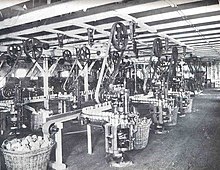
Back تعليب Arabic Konserv Azerbaijani Кансервы Byelorussian Enllaunament Catalan Konzerva Czech Консервăсем CV Κονσερβοποίηση Greek Sterilvakuigo Esperanto Envasado Spanish Ontziratze Basque

Canning is a method of food preservation in which food is processed and sealed in an airtight container (jars like Mason jars, and steel and tin cans). Canning provides a shelf life that typically ranges from one to five years,[a] although under specific circumstances, it can be much longer.[2] A freeze-dried canned product, such as canned dried lentils, could last as long as 30 years in an edible state.
In 1974, samples of canned food from the wreck of the Bertrand, a steamboat that sank in the Missouri River in 1865, were tested by the National Food Processors Association. Although appearance, smell, and vitamin content had deteriorated, there was no trace of microbial growth and the 109-year-old food was determined to be still safe to eat.[3]
- ^ "Food_Product_Dating". Retrieved 24 April 2015.
- ^ "Arctic Explorers Uncover (and Eat) 60-Year-Old Food Stash". Smithsonian. Retrieved 7 November 2018.
- ^ Blumenthal, Dale (September 1990). "The Canning Process; Old Preservation Technique Goes Modern". FDA Consumer. Archived from the original on 9 February 2019.
Cite error: There are <ref group=lower-alpha> tags or {{efn}} templates on this page, but the references will not show without a {{reflist|group=lower-alpha}} template or {{notelist}} template (see the help page).
© MMXXIII Rich X Search. We shall prevail. All rights reserved. Rich X Search